Wai-Fah Chen.The Civil Engineering Handbook
Подождите немного. Документ загружается.

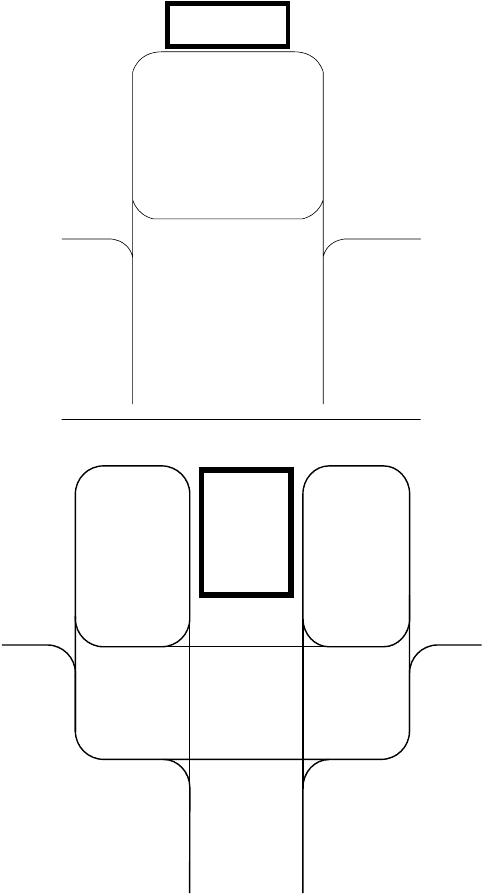
Airport Planning and Design 59-41
Obstacle Control
For the pilot on final approach the runway is an extension of the glide path. The length and slope of the
glide path depend on the airport’s traffic and the approach capability of the runway (visual, instrument
nonprecision, or precision) landing system. The glide path for landing and taking-off aircraft must be
under the control of the airport to the extent that obstacles are avoided, navigation is facilitated, and
landing is safe. Table 59.23 presents the dimensions of the approach surface for transport airports (C and
D aircraft). The obstacles along the glide path pose a most severe situation. At a 50:1 slope, the distance
from the end of the runway to clear a 200-ft (60-m) obstacle by 250 ft (75 m) is 22,500 ft (6850 m or 4.3 mi).
FIGURE 59.25 Four prominent ground access concepts. (From FAA, Planning and Design Guidelines for Airport
Ter minal Facilities, Advisory Circular AC150/5360-13, 1988b.)
Te rminal Unit
Te rminal Frontage
Road
Parking
Recirculation Road
Rental Car Facilities
Service Road
Te rminal Area
Access Road
Airport Access Road
Parking
Parking
Te rminal
Unit
Recirculation Road
Rental Car
Facilities
Service
Road
Te rminal Area
Access Road
Airport Access Road
Te rminal Frontage Road
© 2003 by CRC Press LLC
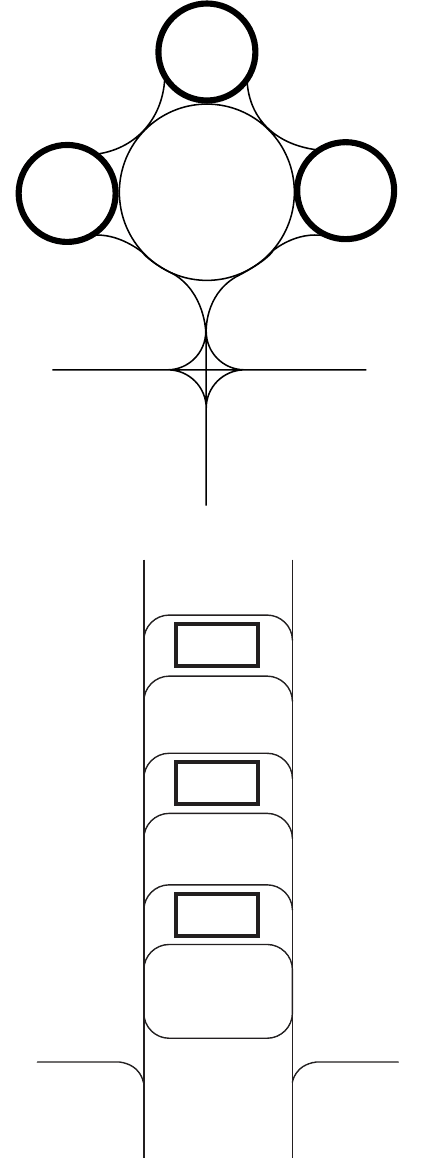
59-42 The Civil Engineering Handbook, Second Edition
FIGURE 59.25 (continued).
Te rminal Unit
Te rminal UnitTer minal Unit
Parking
Rental Car
Facilities
Recirculation
Road
Service Road
Te rminal Frontage
Road
Te rminal Area
Access Road
Airport Access Road
Te rminal
Unit
Te rminal
Unit
Te rminal
Unit
Te rminal Frontage Road
Te rminal Frontage Road
Parking
Parking
Recirculation Road
Rental Car
Facilities
Service Road
Te rminal Area Access Road
Airport Access
Road
© 2003 by CRC Press LLC
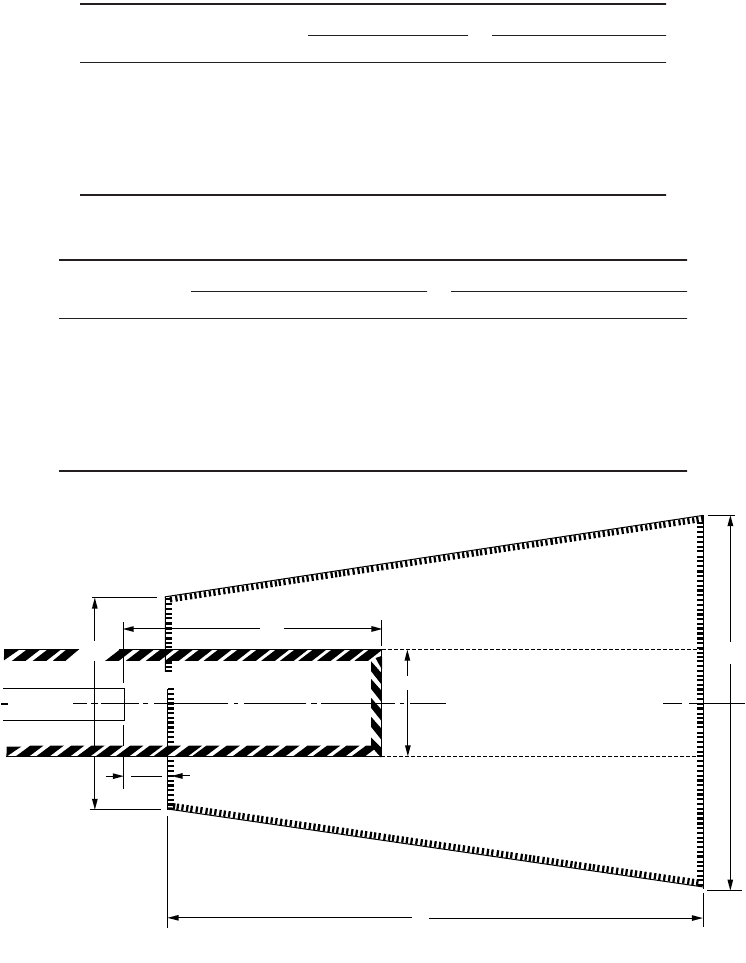
Airport Planning and Design 59-43
The airport is to be sited where it is free from obstructions that could be hazardous to aircraft taking
off or landing. Imaginary surfaces are used to define the limits on potential obstacles on or near the glide
slope. For takeoff these are also critical because it is required that a transport aircraft be able to take off
successfully even if one engine is out. For aviation in the U.S., the imaginary surfaces are set forth in
Part 77 of the Federal Aviation Regulations [FAA, 1975]. The imaginary surfaces are defined in Fig. 59.27.
If the airport is ever to achieve precision instrument status, the precision instrument slope of 50:1 for
TABLE 59.20 Curb Front Requirements from Fort Lauderdale–Hollywood Airport
Mode
Average Dwell Time (s) Curb Front Required (ft-s)
Length (ft) Enplaning Deplaning Enplaning Deplaning
Personal auto 26 130 170 3,380 4,420
Taxi 26 75 130 1,950 3,380
Limousine 36 180 400 6,480 14,400
Courtesy vehicle 46 80 180 3,680 8,280
Bus46270 400 12,420 18,400
Other 36 360 190 12,960 6,840
TABLE 59.21 Example of Curb Front Design for TBA Airport
Enplaning Deplaning
Mode Passengers Vehicles Peak (ft-s) Passengers Vehicles Peak (ft-s)
Personal auto 400 360 1,216,800 420 380 1,679,600
Taxi 100 100 195,000 100 100 338,000
Limousine 80 10 64,800 80 12 172,800
Courtesy vehicle 180 40 147,200 240 50 414,000
Bus 200 10 124,200 120 10 184,000
Other 100 10 129,600 100 12 82,000
1,877,600 2,870,400
FIGURE 59.26 Runway protection zone. (From FAA, Airport Design, Advisory Circular AC150/5300-13, change 1,
1991c.)
Extension of the OFA beyond the
standard length to the maximum
extent practical and feasible
is encouraged.
NOTE:
1. See Table 2-5 for
dimension W
1
, W
2
, L
2. See Tables 3-1 through
3-3 for dimensions R, Q
200'
60 m
RUNWAY
W
1
W
2
RUNWAY OBJECT FREE AREA
R
Q
CONTROLLED
ACTIVITY AREA
L
© 2003 by CRC Press LLC

59-44 The Civil Engineering Handbook, Second Edition
10,000 ft (3,000 m) followed by 40:1 for an additional 40,000 ft (12,000 m) should govern the land-use
policies that restrict building and object heights. For nonprecision instrument landings and visual
landings, there is still a need to control the obstacles out to at least 10,000 ft (3,000 m) at the landing
slope of either 34:1 or 20:1.
In terms of safety, the FAA has established object height requirements in the vicinity of the airport as
follows:
An object would be an obstruction to air navigation if of greater height than 200 ft (60 m) above the
ground at the site, or above the established airport elevation, which ever is higher (a) within 3 nautical
miles (5.6 km) of the established reference point of an airport with its longest runway more than 3200 feet
(975 m) in actual length and (b) that height increases in proportion of 100 feet (30 m) for each additional
nautical mile from the airport reference point up to a maximum of 500 ft (150 m). [U.S. Code FAR, Part
77.23(a)(2)]
Orientation for Winds
The orientation of the runway, in part, results from the physics of the aircraft. Airplanes operate best
when they are flown heading into the wind, so the runway choice, if there one, is always to land (or to
take off) heading directly into the wind. Since the wind varies and the runway is fixed, this is usually not
totally possible. Figure 59.28 shows an aircraft landing on runway 24 in a 25-knot wind blowing from
280 degrees azimuth.
Landing into the wind has also resulted in the convention for numbering runways, where the runway
number consists of the first two digits related to the azimuth of the runway rotated by 180 degrees to
TABLE 59.22 Runway Protection Zone Dimensions for Transport Airports
(C and D Aircraft)
Runway End Dimensions for Approach End
Approach
End
Opposite
End
Length
(ft) [m]
Inner Width
(ft) [m]
Outer Width
(ft) [m]
RPZ Area
(acres)
VV, NP 1000 [300] 500 [150] 700 [210] 13.8
VP 1000 [300] 1000 [300] 1100 [330] 24.1
NP V, NP 1700 [510] 500 [150] 1010 [303] 29.5
NP P 1700 [510] 1000 [300] 1425 [427.5] 47.3
PV, NP, P 2500 [750] 1000 [300] 1750 [525] 78.9
Note: V = visual approach; NP = nonprecision instrument approach (visibility > 3/4
statute mile); P = precision instrument approach.
Source: FAA, Airport Design, Advisory Council AC150/5300-13, change 1, 1991c.
TABLE 59.23 Approach Surface Dimensions for Transport Airport (C and D Aircraft)
Runway End Approach Surface Dimensions
Approach
End
Opposite
End
Length
(ft) [m]
Inner Width
(ft) [m]
Outer Width
(ft) [m]
Slope
(Run:Rise)
VV, NP 5,000 [1500] 500 [150] 1,500 [450] 20:1
VP 5,000 [1500] 1,000 [300] 1,500 [450] 20:1
NP V, NP 10,000 [3000] 500 [150] 3,500 [1050] 34:1
NP P 10,000 [3000] 500 [150] 3,500 [1050] 34:1
PV, NP, P 10,000 [3000] 1,000 [300] 4,000 [1200] 50:1
PLUS + +
40,000 [12,000] 4,000 [1200] 16,000 [4800] 40:1
Note: V = visual approach; NP = nonprecision instrument approach (visibility > 3/4 statute
mile); P = precision instrument approach.
Source: FAA, Airport Design, Advisory Circular AC150/5300-13, change 1, 1991c.
© 2003 by CRC Press LLC
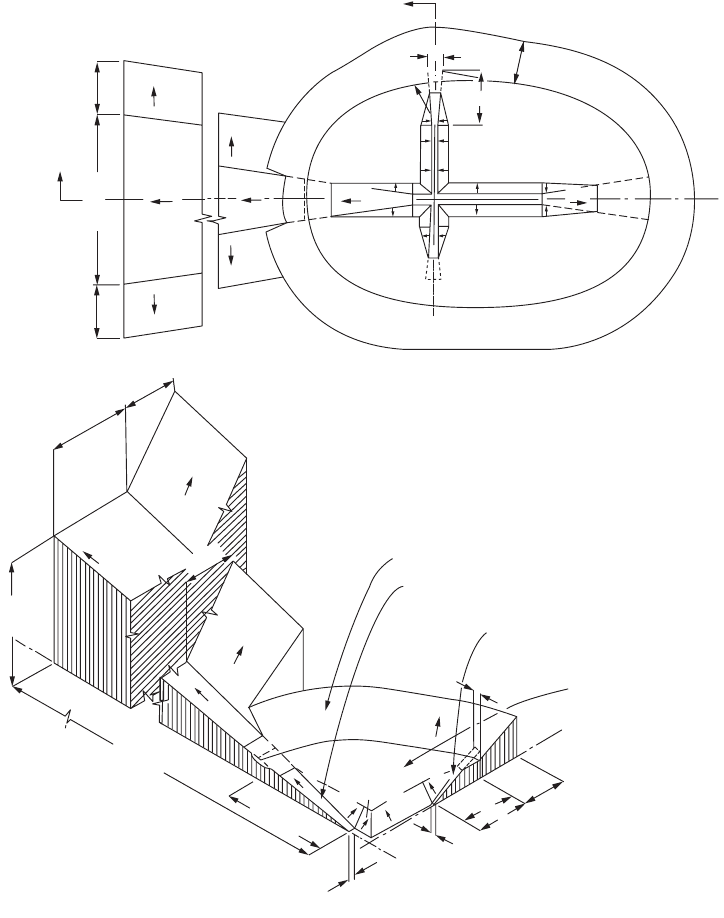
Airport Planning and Design 59-45
account for the direction of the wind. Thus the pilot landing on runway 24 will have the headwind
component of 19.2 knots. The crosswind component of wind is 16 knots. The polar plot displaying these
is called a wind rose.
The FAA standards, given in the U.S. Code (CFR Title 14, Part 25), require that the airport must be
able to accept landing (acceptable level of crosswind at 13 knots) along its runway(s) 95% of the time.
When this cannot be accomplished with one runway, then the airport must add a crosswind runway.
The two runways together then statistically eliminate unacceptable crosswinds to less than 5%. If possible,
a 10-year sample of wind soundings taken hourly is used to establish a model of the wind velocity and
direction. The wind data are then analyzed and placed in the appropriate cell, as shown in the wind rose
FIGURE 59.27 Imaginary surfaces used for obstacle control. All dimensions in feet. (From U.S. Code FAR, Part
77.23, 1975.)
4000
D
B
A
1
_
2
50:1
10,000
50,000
A
1
_
2
(b)
Runway centerlines
C
1
_
2
20:1
40:1
1200
C
8000
1
_
2
_
5000
5000
A
16,000
5000
7 : 1
40:1
5000
40 : 1
7 : 1
7 : 1
7 : 1
40 : 1
7 : 1
7 : 1
7 : 1
7 : 1
50 : 1
7 : 1
7 : 1
7 : 1
7 : 1
7 : 1
7 : 1
7 : 1
7 : 1
7 : 1
7 : 1
7 : 1
20:1 Conical surface
(a)
7 : 1
7 : 1
7 : 1
7 : 1
7 : 1
7 : 1
E
D
B
C
A
4000
E
Horizontal surface, 150 ft
above established
elevation airport
Conical surface
Precision instrument approach
Visual or nonprecision approach
(slope E)
Horizontal surface 150 ft
above established
airport elevation
© 2003 by CRC Press LLC

59-46 The Civil Engineering Handbook, Second Edition
of Fig. 59.29. Thus each cell shows the percentage of the time the wind has an amplitude and a direction
indicated by the cell. The runways are then placed on the wind rose to analyze for minimum crosswinds
in excess of the 13-knot criterion. For each orientation the cells outside the runway template are summed
to determine if the 95% criterion has been met.
The rules relate the crosswind restriction only to the width of the runway, as indicated in Table 59.24.
The crosswind restriction, for example, has been changed for basic transport aircraft to 20 knots [Ashford
and Wright, 1992]. However, there is a trade-off between allowable crosswind and runway width for
lighter planes, which are difficult to control in heavy crosswinds. For example, a 200-foot-wide runway
gives the pilot of a light aircraft much more latitude for maintaining control in a heavy (20-knot)
crosswind (provided the structural integrity of the aircraft is not exceeded) than for landing on a 75-foot-
wide runway. The acceptable practice for most airports has been to ensure that the runway configuration
provides for a minimum of 95% against a 13-knot crosswind. Once the possible best directions of runways
are established, then other factors that impinge on direction obstacles and noise become critical.
Noise
Airport noise has restrained development, constrained operations, and restricted the expansion of many
airports in the U.S. Its presence continues to plague airport managers and operators, who find it con-
tinually impinging on their desire to maintain good community relations. Aircraft primarily produce
noise from their engines and from the flow of air over the aerodynamic surfaces. Jet-turbine-driven
aircraft produce considerably more noise than did their piston engine predecessors.
Noise from airports has evoked numerous lawsuits and excess media attention, much to the frustration
of airport officials. Noise is a real disturbance and its effects and acceptability are best measured in the
ears of the hearer. The critical factors in considering noise impacts are:
•Length or duration of the sound
•Repetition of the sound
•Predominant frequency(ies) generated
•Time of day when the noise occurs
FIGURE 59.28 Head wind and crosswind components on a wind rose.
16 knot
crosswind
component
N
360∞
26
27
22
21
17
16
11
350∞
340∞
330
∞
320
∞
310∞
300∞
290∞
280
∞
270∞
250∞
230∞
220∞
210∞
200∞
190∞
180
∞
170
∞
160
∞
150∞
140∞
130∞
120∞
110
∞
100∞
90∞
80
∞
70∞
50∞
40∞
NE
ENE
ESE
SE
SSE
SSW
SW
WSW
WNW
NW
NNW
W
19.2 knot
headwind
component
S
∞
260∞
E
24
6
'U knots
25 knot wind
© 2003 by CRC Press LLC

Airport Planning and Design 59-47
Loudness is the subjective magnitude of noise that doubles with an increase of 10 decibels. The human
ear is not sensitive to all noise in the aircraft-generating frequency range of 20 to 20,000 Hz. Usually it
perceives noise in the middle of the range, 50 to 2000 Hz, called the A range. Sound-measuring devices
generally measure noise in the A range in decibels (dBA). However, with aircraft noise, the simple dBA
or sound intensity was discarded as a definitive measure because it lacked correlation to the perceived
noise disturbance heard by the human ear [Ashford et al., 1991].
This led to two single-event noise measures: the sound exposure level (SEL) and the effective perceived
noise level (EPNL). SEL is computed by accumulating instantaneous sound levels in dBA over the time
the sound of the individual event is detectable. EPNL incorporates not only the sound level, but its
frequency distribution and duration as well. Equation (59.11) shows how the EPNL is calculated:
(59.11)
FIGURE 59.29 Wind data and wind rose analysis. (From FAA, Airport Design, Advisory Circular AC150/5300-13,
change 1, 1991c.)
01 469 842 568 212 2091 6.2 7.1
02 568 1263 820 169 2820 6.0 6.9
03 294 775 519 73 9 1670 5.7 6.6
04 317 872 509 62 11 1771 5.7 6.6
05 268 861 437 106 1672 5.6 6.4
06 357 534 151 42 8 1092 4.9 5.6
07 369 403 273 84 36 10 1175 6.6 7.6
08 158 261 138 69 73 52 41 22 814 7.6 8.8
09 167 352 176 128 68 59 21 971 7.5 8.6
10 119 303 127 100 98 41 9 877 9.3 10.7
11 323 506 268 312 111 23 28 1651 7.9 9.1
12 618 1397 624 779 271 69 21 3779 8.3 9.6
13 472 1375 674 531 452 67 3571 8.4 9.7
14 647 1377 974 781 129 3008 6.2 7.1
15 338 1093 348 135 27 1947 5.6 6.4
16 560 1399 523 121 19 2622 5.5 6.3
17 587 883 469 128 12 2079 5.4 6.2
18 1046 1904 1068 297 83 10 4496 5.8 6.7
19 499 793 506 241 92 2211 6.2 7.1
20 371 946 615 243 64 2239 6.6 7.6
21 340 732 528 323 147 8 2078 7.6 8.8
22 479 768 603 231 115 38 19 2253 7.7 8.9
23 107 1008 915 413 192 2715 7.9 9.1
24 458 943 800 453 96 11 18 2779 7.2 8.2
25 351 699 752 297 102 21 9 2431 7.2 8.2
26 368 731 379 208 53 1739 6.3 7.2
27 411 748 469 232 118 19 1997 6.7 7.7
28 191 554 276 287 118 1426 7.3 8.4
29 271 642 548 479 143 17 2100 8.0 9.3
30 379 873 526 543 208 34 2563 8.0 9.3
31 299 643 597 618 222 19 2398 8.5 9.8
32 397 852 521 559 150 23 2510 7.9 9.1
33 236 721 324 238 48 1567 6.7 7.7
34 280 916 845 307 24 2372 6.9 7.9
35 252 931 918 307 24 2611 6.9 7.9
36 501 1568 1381 569 27 4046 7.0 8.0
00 7729 7720 0.0 0.0
Total 21676 31828 19849 10437 3357 529 166 22 87864 6.9 7.9
Direction
TOTAL KNOTS MPH
HOURLY OBSERVATIONS OF WIND SPEED
AVERAGE
SPEED
0–3 4–6 7–10 11–16 17–21 22–27 28–33 34–40 OVER
MPH 47
0–3 4–7 8–12 13–18 19–24 25–31 32–38 39–46 OVER
41KNOTS
WIND DIRECTION VERSUS WIND SPEED
STATION: Anywhere, USA HOURS: 74 Observations/Day PERIOD OF RECORD: 1964–1973
EPNL =
Ú
()
10
1
10
0
01
log
.
T
dt
T
Lt
© 2003 by CRC Press LLC
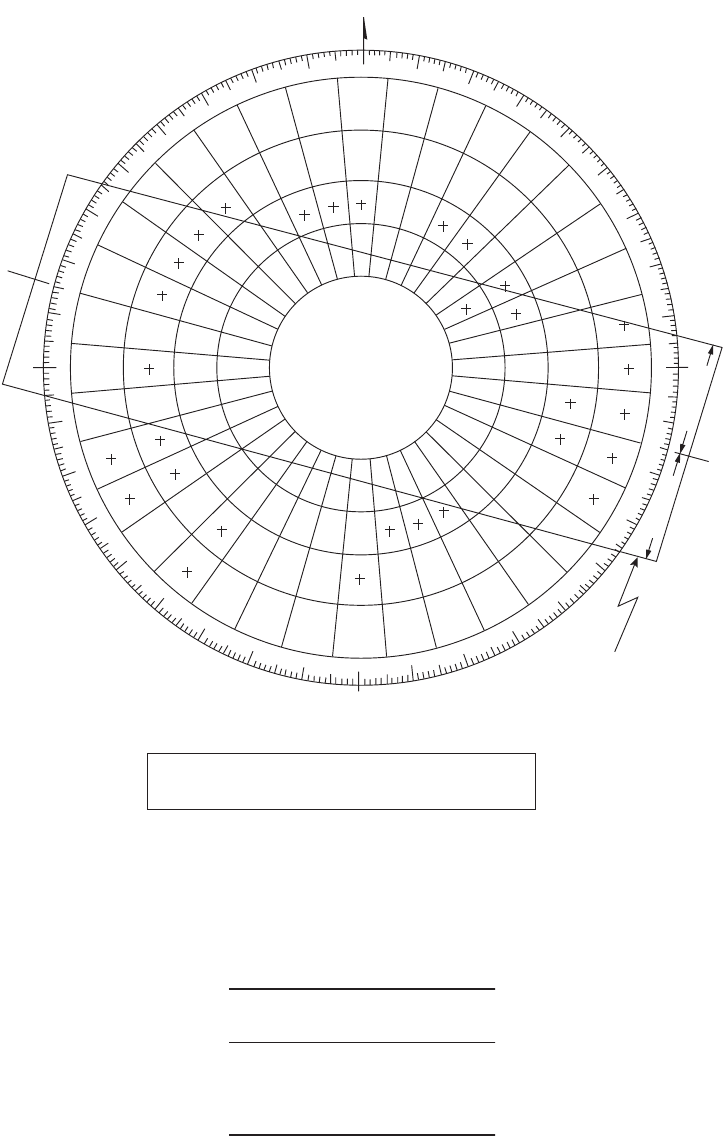
59-48 The Civil Engineering Handbook, Second Edition
FIGURE 59.29 (continued).
TABLE 59.24 Runway Width and
Allowable Crosswind for Landing
Runway
Width W (ft)
Allowable Crosswind
Component (knots)
W < 75 10.5
75 £ W < 100 13
100 £ W < 150 16
W ≥ 150 20
Source: FAA, Airport Design, Advisory
Circular AC150/5300-13, change 1, 1991c.
1
0
K
n
o
t
s
220
∞
230∞
240
∞
250∞
240∞
210∞
200∞
190∞
170∞
160∞
150∞
140∞
130∞
120∞
110∞
100∞
90∞
80∞
70∞
60∞
50∞
40∞
30∞
20∞
10∞
360∞
350∞
340∞
330∞
320∞
310∞
300∞
290∞
280∞
270∞
180∞
13 KNOTS
13 KNOTS
E
SE
SSE
PLASTIC TEMPLATE
A runway at the airport represented by the wind data on the left
that is oriented 105∞ - 285∞ (true) would have 2.72% of the winds
exceeding the design crosswind/crosswind component of 13 knots.
S
SSW
SW
WSW
W
WNW
NW
NNW
N
NNE
NE
ENE
.1
.1
.1
.2
.2
.2
.2
.2
.2
.2
.2
.3
.3
.3
.3
.3
.3
.3
.3
.3
.3
.4
.1
.1
.1
.1
.1
17
22
21
27
28
IE
.1
.1
.1
.5
.5
.5
.5
.6
.6
.9
.4
.2
.4
.6
.6
.6
.7
.3
.1
.1
.1
.1
.1
.1
.1
11
.1
84.1%
+
.1
.1
.1
.1
.1
© 2003 by CRC Press LLC

Airport Planning and Design 59-49
where L(t) = the sound level in dBA
T = 20 to 30 seconds to avoid quiet periods between aircraft
Since the irritation from noise comes not from a single event but from the integrated or cumulative
measure of many events, EPNL and SEL, in and of themselves, are not useful metrics for modeling the
impact from aircraft noise in the vicinity of an airport.
One of the models that has come to be accepted is the noise exposure forecast (NEF), which embeds
EPNL in its definition [Ashford et al., 1991]. The NEF has two different measures, depending on the
time of day of the aircraft operation. Equation (59.12) indicates the NEF for day or night, while Eq. (59.13)
shows how the day and night measures are combined.
(59.12)
where N = the number of occurrences exceeding 80 decibels (peak level of noise from a Boeing 707
at full power at a 12,000-foot altitude)
K = 88 for daytime operations (0700–2200) and 76 for nighttime operations (2200–0700)
(59.13)
More recently the FAA, airports, and community officials have adopted a cumulative noise measure
based on SEL [FAA, 1983a]. Nighttime operations are weighted by a factor of 10, due to the additional
disturbance from such operations. The measure is called the average day–night sound exposure or L
DN
.
Equation (59.14) indicates how L
DN
is determined for each significant noise intrusion for the ith aircraft
class and the jth operational mode. Each single event (i, j) is then summed on an energy basis to obtain
the total L
DN
:
(59.14)
where Ops
day
= the number of daytime operations (0700–2200 hours)
Ops
night
= the number of nighttime operations (2200–0700 hours)
SEL = the average sound exposure level
i = the ith aircraft class
j = the jth operational mode
Having computed the noise level generated by each specific aircraft using the schedule of flights, it is
then necessary to determine the effect the noise will have on the community. How much noise is too
much? In what situations? Figure 59.30 shows one sample from a social survey indicating that below
50 decibels on the day–night average sound level there is virtually no annoyance. Table 59.25 describes
how communities and Housing and Urban Development (HUD) have integrated the noise impacts into
land-use planning recommendations (or regulations) in the community. While noise levels of L
DN
below
65 decibels are considered acceptable by some, experience has indicated that airports would do well to
plan their land acquisition program for L
DN
levels below 60 or even 55 decibels.
Integrated Noise Model
The computer software for determining the impact of noise around an airport is called the Integrated
Noise Model (INM). Available for licensing from the FAA Office of Environment and Energy, it can give
the contours of equal noise exposure for any one of four different measures indicated in Table 59.26. The
inputs are the airport elevation, ambient temperature, runway geometry, percentage use of each runway,
NEF EPNL=+ -10
10
log NK
NEF anti
NEF
anti
NEF
day night
day night
=+
Ê
Ë
Á
ˆ
¯
˜
10
10 10
10
log log log
L
L
DN
DN
=
()
()
10 10
10
10
log
,
SS
ij
ij
© 2003 by CRC Press LLC

59-50 The Civil Engineering Handbook, Second Edition
number of operations during the day and at night, expected aircraft in each time space, and expected
tracks of approach and takeoff in several altitude and distance segments.
Figure 59.31 shows a three-runway airport with the operational flight tracks that are to be used in
computation of the noise. The noise along each track will differ depending on the number of aircraft in
a day, the nighttime traffic, and the specific aircraft that are anticipated to fly each track. The model
stores a database of existing aircraft by make, model number, the number of aircraft in a day, the nighttime
traffic, and the specific aircraft that are anticipated to fly each track. Included are their altitude profiles
FIGURE 59.30 Degree of annoyance from noise observed in social surveys. (From Schultz, T.J., Synthesis of social
surveys on noise annoyance, J. Acoustical Soc. Am., 64, 1978.)
TABLE 59.25
Land Use for Various Levels of Airport Noise
Land-Use
Zones
Noise Exposure
Class L
DN
NEF
HUD Noise
Guidelines
Suggested Land-Use
Controls Recommended Land Use
AMinimal 0–50 0–20 Acceptable Normally requires no
special consideration
Residential, cultural, public
assembly, schools, resorts,
mobile homes, parks, service
BLow moderate 55–60 20–25 Normally
acceptable
Some sound-reducing
controls may be useful
Residential, hotels,
apartments, business
services, office complexes,
light industry
BC High moderate 60–65 25–30 Sometimes
acceptable
Some sound-reducing
controls may be useful
See note
CSignificant 65–75 30–40 Normally
unacceptable
Noise easements required
with strict land-use
controls
Manufacturing, retail trade,
construction services,
refining, paper/pulp
DSevere >75 >40 Clearly
unacceptable
Should be within the
airport boundary; use of
positive compatibility
controls required
Highway right way, motor
vehicle transportation, rail
transit, undeveloped area,
heavy industry, farming
Note: Airport consultants pay special attention to areas impacted or potentially impacted by noise levels of NEF 25–30 and
L
DN
60–65. Experience indicates that owners of property in these areas of noise transition from normally acceptable to normally
unacceptable noise are frequently involved in noise litigation suits. The FAA has set L
DN
limits at 65. Practitioners consider
residential uses regardless of density as unacceptable land use below 60 dB. This is particularly true under the glide paths or
tracks for landing or takeoff. The Environmental Protection Agency suggests that the safe L
DN
criterion for “health and welfare”
is 55 dB [EPA, 1974]. They set 60 dB with a 5-dB safety margin for outdoor noise in a residential neighborhood. (Adapted
from FAA, Airport Land Use Compatibility Planning, Advisory Circular AC150/5050-6, 1983.)
40 50 60 70 80
90
0
10
20
30
40
50
60
70
80
Day/night average sound level (dB)
Percent highly-annoyed
© 2003 by CRC Press LLC
